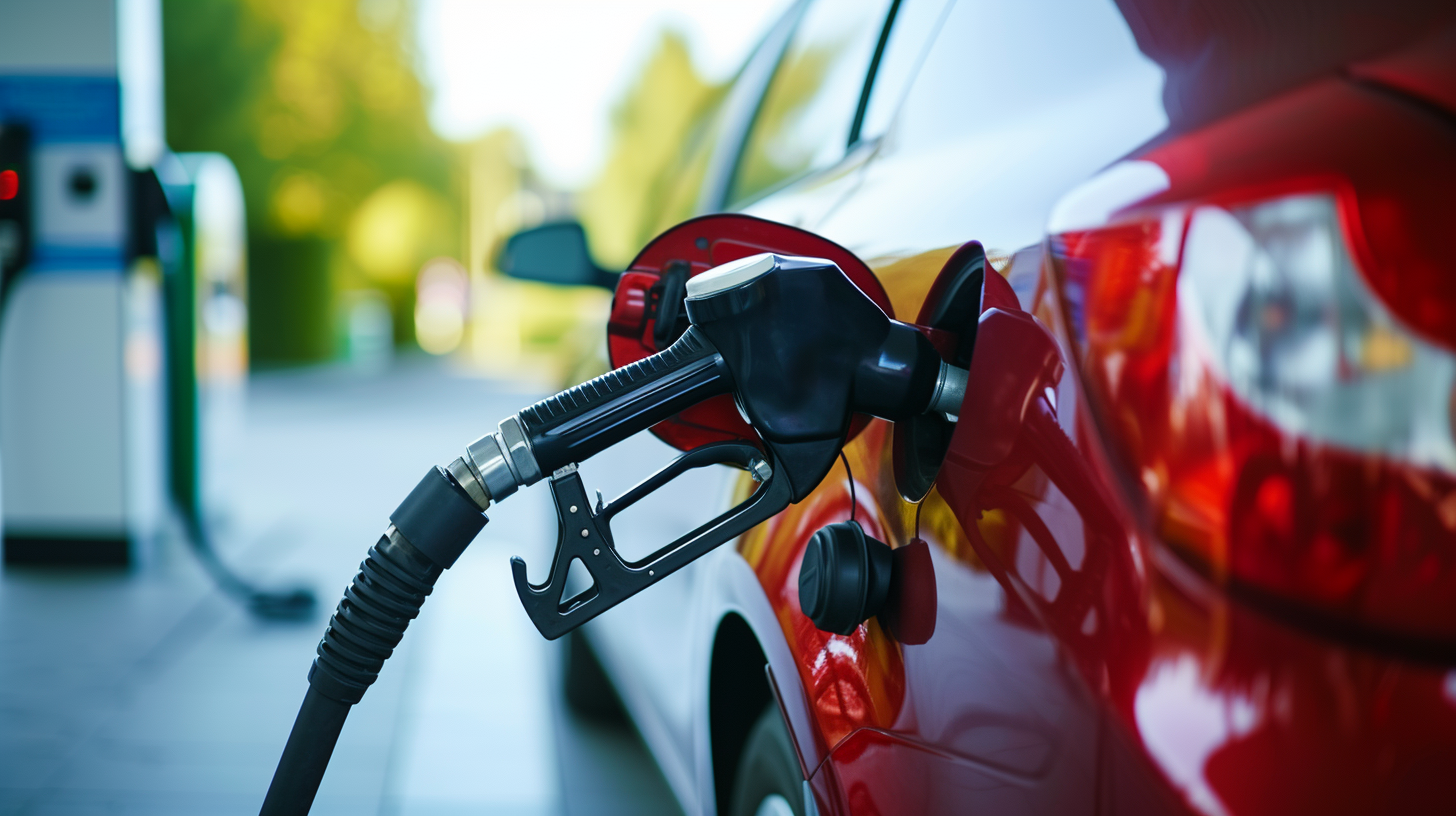Want to save money at the pump? Learn how to improve your car’s fuel economy with these simple tips. Understand how your car’s fuel efficiency works, choose the right fuel for your vehicle, and keep your tires properly inflated. Don’t forget to reduce excess weight in your car and use cruise control on the highway. By avoiding excessive idling and planning your trips efficiently, you’ll see significant savings. Regular service and tune-ups, along with considering alternative transportation options, can also make a difference.
Understand Your Car’s Fuel Efficiency
You should start by understanding how many miles per gallon your car gets. This information is crucial in improving your car’s fuel economy. To determine your car’s fuel efficiency, you can refer to the owner’s manual or check the sticker on the driver’s side door jamb. Once you know the MPG (miles per gallon) rating, you can make informed decisions to improve your car’s fuel economy. By driving at a consistent speed, avoiding aggressive acceleration and braking, and properly maintaining your car, you can maximize fuel efficiency. It is also important to keep track of your mileage and calculate your fuel consumption regularly. Understanding your car’s fuel efficiency will empower you to take steps towards reducing fuel consumption and saving money at the pump.
Choose the Right Fuel for Your Vehicle
To maximize your car’s fuel economy, choose the right fuel for your vehicle. Not all fuels are created equal, and using the right one can make a significant difference in how efficiently your car runs. Start by checking your car’s owner’s manual to see what type of fuel is recommended by the manufacturer. Most cars are designed to run on regular unleaded gasoline, but some high-performance vehicles may require premium fuel. Using a higher octane fuel than what your car requires will not improve performance or fuel efficiency, so stick to the recommended type. Additionally, consider using a fuel that contains cleaning additives to help keep your engine running smoothly and maintain optimal fuel efficiency.
Keep Your Tires Properly Inflated
To improve your car’s fuel economy, it’s crucial to keep your tires properly inflated. Maintaining the correct tire pressure not only ensures optimum performance but also contributes to better fuel efficiency. Regularly checking and maintaining tire pressure is a simple yet effective maintenance tip that can help you save money on fuel in the long run.
Tire Pressure Importance
Make sure your car’s tires are properly inflated to improve fuel efficiency. Maintaining the correct tire pressure is essential for getting the most out of your vehicle’s fuel economy. When your tires are underinflated, it increases the rolling resistance, causing your engine to work harder and burn more fuel. On the other hand, overinflated tires can lead to reduced traction and uneven wear, resulting in a decrease in fuel efficiency. By regularly checking your tire pressure and inflating them to the manufacturer’s recommended level, you can optimize your car’s performance and save money on fuel costs. Additionally, properly inflated tires also improve handling and safety, as they provide better grip on the road, especially in wet or slippery conditions. So, take a few minutes to check and adjust your tire pressure regularly, and enjoy the benefits of improved fuel economy.
Fuel Efficiency Benefits
Check your tire pressure regularly to maximize fuel efficiency. Keeping your tires properly inflated can have significant benefits when it comes to saving fuel. When your tires are underinflated, they create more rolling resistance, which means your engine has to work harder to move the car forward. This increased effort leads to higher fuel consumption and lower fuel efficiency. On the other hand, properly inflated tires reduce rolling resistance, allowing your car to move more easily and efficiently. By regularly checking and maintaining the correct tire pressure, you can improve your car’s fuel economy by up to 3%. It’s a simple and cost-effective way to save money on fuel and reduce your carbon footprint. So, make it a habit to check your tire pressure regularly and enjoy the fuel efficiency benefits.
Regular Maintenance Tips
Maintaining the proper tire pressure is key to improving your car’s fuel economy by up to 3%. Regularly checking and inflating your tires to the recommended pressure level not only ensures safety but also helps you save money on fuel. When your tires are underinflated, they create more rolling resistance, which requires your engine to work harder and consume more fuel. On the other hand, overinflated tires can lead to reduced traction and uneven wear. To keep your tires properly inflated, use a tire pressure gauge to measure the pressure when the tires are cold. Refer to your car’s manual or the sticker located on the driver’s side door jamb for the recommended tire pressure. By keeping your tires properly inflated, you can maximize your car’s fuel efficiency and enjoy smoother rides.
Reduce Excess Weight in Your Car
You can easily lighten your car by removing unnecessary items from the trunk. Carrying around extra weight in your vehicle can significantly impact its fuel economy. Take a moment to assess what you have stored in your trunk and remove anything that is not essential. Items like sports equipment, tools, or old boxes can add unnecessary weight and increase fuel consumption. Remember to also check the backseat and other storage compartments for any items that you no longer need to carry around. By reducing the excess weight in your car, you can improve its fuel efficiency and save money on gas. So, take the time to declutter and remove any unnecessary items from your car to lighten the load and increase your fuel economy.
Use Cruise Control on the Highway
To improve your car’s fuel economy, using cruise control on the highway can be highly beneficial. By utilizing cruise control, you can decrease fuel consumption by maintaining a consistent speed, which eliminates unnecessary acceleration and deceleration. This not only saves fuel but also enhances your driving efficiency, allowing for a smoother and more relaxed driving experience.
Decreased Fuel Consumption
Using cruise control on the highway can significantly reduce your car’s fuel consumption. When you activate cruise control, your car maintains a constant speed, which helps to eliminate unnecessary acceleration and deceleration. This constant speed ensures that your engine operates efficiently, resulting in decreased fuel consumption. By keeping a steady pace, cruise control prevents you from inadvertently speeding up and wasting fuel. Additionally, cruise control helps to minimize the effects of human error, such as unintentionally pressing too hard on the accelerator or failing to maintain a consistent speed. It is important to note that cruise control is most effective on flat terrain and smooth roads, as it may not be as efficient on hilly or uneven surfaces. Nonetheless, incorporating cruise control into your highway driving habits can lead to noticeable fuel savings.
Consistent Speed Maintenance
Maintain a consistent speed on the highway by utilizing cruise control. When you set your car’s cruise control at a specific speed, it helps in maintaining a steady pace. This prevents unnecessary acceleration and deceleration, which can consume more fuel. By keeping a consistent speed, you allow your car’s engine to operate at its most efficient level, resulting in better fuel economy. Cruise control also helps you avoid unintentionally exceeding the speed limit, which can lead to wasted fuel due to excessive speed. Additionally, using cruise control reduces the chances of getting caught in the traffic flow and eliminates the need for constant speed adjustments, further improving your car’s fuel efficiency. So, remember to engage cruise control when driving on the highway to save on fuel consumption.
Enhanced Driving Efficiency
For improved driving efficiency on the highway, try engaging the cruise control feature in your car. Cruise control helps maintain a consistent speed, which can optimize your fuel economy. When you manually accelerate and decelerate, you may unknowingly use more fuel than necessary. However, with cruise control, you can set your desired speed and let the car take care of maintaining it. This not only reduces the risk of inadvertently speeding, but it also helps prevent unnecessary fuel consumption caused by sudden acceleration or braking. By using cruise control, you can keep a steady pace, allowing your engine to operate at its most efficient level. So, next time you hit the highway, give cruise control a try and enjoy the benefits of enhanced driving efficiency and improved fuel economy.
Avoid Excessive Idling
To maximize fuel efficiency, you should avoid excessive idling in your car. When you leave your engine running while parked, even for a short period of time, you are wasting fuel. Idling for more than 10 seconds consumes more fuel than restarting your engine. Instead of idling, consider turning off your engine if you anticipate being stationary for more than a minute. This includes situations like waiting in a long drive-thru line or waiting to pick someone up. Additionally, avoiding excessive idling not only saves fuel, but it also reduces emissions that contribute to air pollution. By making a conscious effort to turn off your engine when it’s not necessary, you can improve your car’s fuel economy and reduce your environmental impact.
Plan Your Trips Efficiently
Make sure you consider the most efficient routes and avoid unnecessary detours when planning your trips. By taking the time to plan your routes in advance, you can significantly improve your car’s fuel economy. Start by using a GPS or mapping app to find the most direct and efficient routes to your destinations. Consider traffic conditions, road closures, and any potential delays that could affect your journey. Additionally, try to consolidate your errands and appointments into one trip to minimize the number of separate trips you need to make. This will not only save you time but also reduce the amount of fuel consumed. By planning your trips efficiently, you can maximize your car’s fuel efficiency and ultimately save money at the gas pump.
Maintain Regular Service and Tune-Ups
Regularly servicing and tuning up your car can significantly improve its fuel economy. By maintaining regular service and tune-ups, you ensure that your car’s engine is running efficiently and smoothly. A well-maintained engine consumes less fuel and performs better, resulting in improved fuel economy. During a tune-up, the mechanic will check and replace any worn-out parts, clean the fuel injectors, and adjust the ignition timing. These actions help optimize the engine’s performance, resulting in better fuel efficiency. Additionally, regular service includes changing the oil and air filters, as well as checking the tire pressure and wheel alignment. By keeping your car in top condition, you not only improve its fuel economy but also extend its lifespan and reduce the risk of breakdowns.
Consider Alternative Transportation Options
If you want to save money on fuel and reduce your carbon footprint, consider using alternative transportation options. Instead of relying solely on your car, you can explore other ways to get around. One option is public transportation, such as buses or trains, which can be more cost-effective and environmentally friendly. Carpooling is another great alternative, where you can share a ride with others going in the same direction. Not only does this help reduce traffic congestion, but it also saves you money on fuel and parking costs. Additionally, you can consider biking or walking for shorter trips. Not only is this a great way to save on fuel, but it also provides health benefits. So, next time you need to go somewhere, think about the alternative transportation options available to you.

Lucas is an experienced vehicle technician with hands-on knowledge of almost every car brand available. Throughout his career, Lucas has worked on a wide range of vehicles, including domestic and foreign models, sports cars, trucks, and SUVs.





